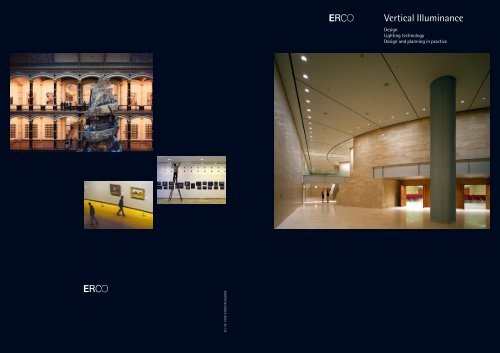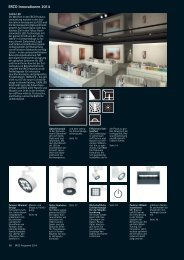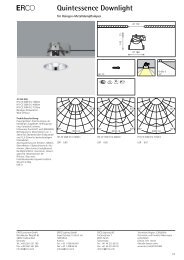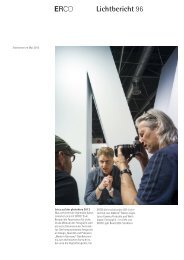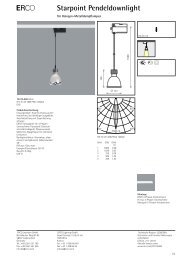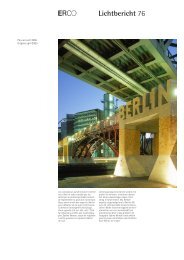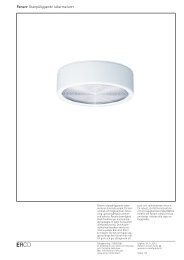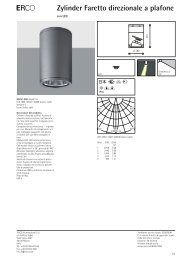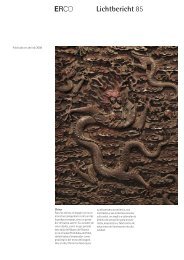Vertical Illuminance - Erco
Vertical Illuminance - Erco
Vertical Illuminance - Erco
You also want an ePaper? Increase the reach of your titles
YUMPU automatically turns print PDFs into web optimized ePapers that Google loves.
4<br />
E<br />
Art.-Nr. 1029151000 EN 05/2005<br />
E<br />
<strong>Vertical</strong> <strong>Illuminance</strong><br />
Design<br />
Lighting technology<br />
Design and planning in practice<br />
1
1<br />
2–3<br />
4–5<br />
6–7<br />
8–9<br />
10–11<br />
12–13<br />
14-15<br />
16-17<br />
18-19<br />
20–23<br />
24–25<br />
26–27<br />
28–29<br />
Contents<br />
The Light Factory<br />
Light defines space<br />
Designing vertical illuminance<br />
The basics<br />
Internal areas<br />
External areas<br />
Internal and external areas – seen holistically<br />
Colour and scenography<br />
Lighting tools<br />
Internal areas: wallwashers for track and light structures<br />
Internal areas: recessed luminaires<br />
External areas: floodlights and wallwashers<br />
Design and planning in practice<br />
Luminaire selection and arrangement<br />
Experience light – globally<br />
ERCO showrooms and offices<br />
Lighting preview<br />
Virtual luminaires and simulation<br />
ERCO addresses<br />
ERCO head office,<br />
Lüdenscheid<br />
The Light Factory<br />
First and foremost, ERCO sells light and not<br />
luminaires. This approach, which places the<br />
immaterial ”software” of light above the<br />
luminaire hardware, has characterised our<br />
work for many years: that’s why we call ourselves<br />
ERCO, the Light Factory. Light interprets<br />
space and helps us to perceive and experience<br />
its atmosphere. In this sense, we understand<br />
light as the “fourth dimension” of architecture.<br />
Making good architecture even better by<br />
setting it in the right light, is where we see our<br />
cultural contribution and the purpose of our<br />
activity. Today ERCO illuminates museums,<br />
universities, window displays, churches, airports,<br />
hotels, retail chains, trade fair stands,<br />
administrative buildings, private houses and<br />
much more. Regardless of whether the architectural<br />
concept puts functionality or image<br />
to the fore, the goal is always to find a solution<br />
that does justice to the specific usage<br />
and architectural features of each individual<br />
project.<br />
ERCO’s indoor luminaires, outdoor<br />
luminaires and lighting control systems form<br />
a comprehensive programme of lighting tools<br />
for integrated, holistic lighting solutions in<br />
architecture. The luminaire is a lighting instrument,<br />
a lighting tool for a specific purpose.<br />
This all leads to the conclusion that the illumination<br />
of walls and other vertical surfaces<br />
in architecture also requires dedicated instruments.<br />
The aesthetic and technical aspects<br />
of this form of lighting are the theme of this<br />
brochure.<br />
1
Le Corbusier defined architecture as “the masterly,<br />
correct and magnificent interplay of<br />
masses brought together in light”. His skill in<br />
the use of space and volume was consummate<br />
– but he would envy modern designers the<br />
options they have today for shaping and<br />
forming light itself as a medium.<br />
With light, spaces can be defined and reinterpreted<br />
time and time again. Looking at<br />
walls and other surfaces, it becomes clear that<br />
these are decisive for the appreciation of architectural<br />
form: illuminated walls allow us to<br />
perceive the form and dimensions of a space;<br />
they make the entire space seem bright. A wall<br />
which is evenly illuminated gives an impression<br />
of being almost intangible. Objects such<br />
as photos, posters or paintings can be optimally<br />
viewed.<br />
The lighting tools for this type of lighting<br />
are wallwashers. ERCO has been developing<br />
and perfecting these specialised luminaires for<br />
decades. The result is a range of instruments<br />
for the illumination of vertical surfaces which<br />
is hard to equal in terms of range and variety.<br />
Wallwashing is one of the most demanding<br />
types of lighting in terms of design and technology.<br />
The possibilities that this form of light<br />
offers design, the tools suitable for specific<br />
purposes and how they are best used – these<br />
questions and others will be dealt with on the<br />
following pages.<br />
Light defines space<br />
2 3
Spatial effect<br />
<strong>Vertical</strong> illuminance is a component of lighting<br />
design that is vitally important to architecture.<br />
Its primary purpose is to make spatial propor-<br />
tions and spatial limits visible. The opposite<br />
is the conventional horizontal illuminance,<br />
which is frequently the result of a purely functional,<br />
utilitarian and quantitative approach<br />
to design. In this latter case, the spatial experience<br />
is often secondary to the immediate<br />
visual task.<br />
<strong>Vertical</strong> illuminance, however, can help complement<br />
the functional lighting design as well<br />
as become a starting point for architecturally<br />
orientated lighting concepts.<br />
Illuminated walls give the observer a bright<br />
and open spatial impression. The fascination<br />
of wallwashing arises not only from the perception<br />
of brightness but also from the clear<br />
spatial presentation, which organises the architecture<br />
thereby making the surroundings<br />
more comprehensible.<br />
From the point of view of perception psychology<br />
and aesthetics, wallwasher lighting<br />
is an important concept for constructing<br />
spaces with light. It is for this reason that it<br />
belongs to the essential repertoire of qualitative<br />
lighting design.<br />
4<br />
Designing vertical illuminance<br />
The basics<br />
Through uniform wallwashing<br />
a clear spatial<br />
presentation occurs,<br />
which makes the architecture<br />
more legible<br />
and creates a bright<br />
spatial impression.<br />
The functional advantages<br />
of wall illuminance<br />
are especially<br />
apparent when it<br />
comes to museum<br />
lighting. Appropriate<br />
illumination puts the<br />
artwork in the right<br />
light.<br />
Light from point<br />
sources produces a<br />
scalloped pattern on<br />
the wall. These are not<br />
perceived as beams of<br />
light but as patterns in<br />
their own right.<br />
The uniform light distribution<br />
from the ceiling<br />
to the floor emphasises<br />
the wall as a whole and<br />
gives a wide spatial<br />
impression.<br />
Lighting Options for Walls<br />
Three different approaches to vertical illuminance<br />
give the lighting designer considerable<br />
artistic freedom for a differentiated approach<br />
to the lighting of walls. Of particular interest<br />
from the architectonic point of view is the<br />
practice of uniform wallwashing. An even<br />
light distribution from the ceiling to the floor<br />
emphasises the surface of the whole wall as<br />
a single unit. This approach achieves a bright<br />
spatial impression and brings the wall to the<br />
fore in its function as a delineating surface.<br />
A second approach is to use grazing light up<br />
against the wall, the brightness distribution<br />
decreases across the wall. This type of lighting<br />
in particular brings out the material nature<br />
and texture of the wall surfaces. Point-source<br />
luminaires generate brilliant lighting effects.<br />
Conversely, linear sources produce a soft and<br />
diffuse effect.<br />
The third method of illuminating walls is<br />
from point sources. The regular sequence of<br />
beam intersections or “scallops” forms a pattern<br />
and lends the wall surface a rhythm of<br />
brightness contrasts.<br />
Special lighting tools are available for each<br />
of the different wallwashing techniques. Uniform<br />
wallwashing places the highest demands<br />
on the lighting technology. Various designs of<br />
wallwasher are available for this area of architecture.<br />
Grazing light right next<br />
to the wall is an excellent<br />
way of bringing<br />
out the surface texture<br />
of materials using the<br />
interplay of light and<br />
shadow.<br />
5
Wallwashing aids orientation<br />
in entrance<br />
areas: visitors understand<br />
the structure<br />
of a room faster and<br />
assimilate important<br />
information quicker.<br />
Particular details on<br />
walls such as inscriptions<br />
become even<br />
more noticeable.<br />
Regardless of whether<br />
it is large-format advertising<br />
surfaces or walls<br />
with artworks in museums<br />
that are to be illuminated<br />
– uniform,<br />
vertical illuminance is<br />
an effective concept<br />
to illuminate walls and<br />
objects.<br />
Designing vertical illuminance<br />
Internal areas<br />
The combination<br />
of wallwashers and<br />
spotlights allows the<br />
general lighting to<br />
be supplemented by<br />
accent lighting.<br />
It is not only the architectural design task that<br />
falls to vertical lighting in the indoor area but<br />
also that of a contribution towards perception.<br />
The classic visual tasks include recognising the<br />
environment and reading information on<br />
walls. The latter ranges from text information<br />
for orientation, paintings in galleries and<br />
museums through to merchandise in the<br />
world of shopping.<br />
Uniform wallwashing holds great artistic<br />
potential: the wall itself can only be emphasised<br />
with its spatial and material quality<br />
or used as a neutral background for wallmounted<br />
objects. The practice of reflecting<br />
light off walls produces a diffuse component<br />
of light in the room and this can be used as<br />
ambient lighting.<br />
In particular, the areas of exhibitions and<br />
retail, whose pictures or merchandise are<br />
changed frequently, require a flexible lighting<br />
concept for walls. Uniform wallwashing offers<br />
a technique for the illumination of objects<br />
which does not require the luminaires to be<br />
constantly re-aimed to cater for rotating<br />
exhibits. It can also provide excellent presentation<br />
lighting. In the retail area, uniform<br />
wallwashing ensures that displays above the<br />
shelves are adequately illuminated.<br />
Special wallwashers are suitable for largeformat,<br />
full-height, advertising information<br />
because they bring the advertisement’s entire<br />
surface to bear evenly and, by using high illuminance<br />
levels, are excellent for attracting<br />
attention.<br />
Wall lighting in the daytime<br />
reduces the contrast<br />
of bright facades<br />
and room walls. At<br />
night, the even lighting<br />
of wall areas ensures a<br />
bright spatial impression<br />
is maintained.<br />
Luminaires installed<br />
directly against the<br />
wall do not achieve<br />
uniform brightness<br />
from top to bottom.<br />
The linear grazing light<br />
of fluorescent lamps<br />
produces a diffuse light<br />
on the wall and creates<br />
a clear definition at<br />
the edge of the room<br />
where the wall meets<br />
the ceiling.<br />
Although the use of horizontal workplace<br />
lighting is widespread in the office and administrative<br />
area, wallwashing can make a valuable<br />
contribution to the users’ wellbeing in<br />
this area. Because the luminance influences<br />
the impression of brightness in the viewer’s<br />
field of vision, the lighting of walls takes on an<br />
important role especially in small offices. This<br />
not only concerns having sufficient illuminance<br />
for visual tasks in places such as shelves<br />
or cabinets, but also the lighting of walls and<br />
graphic art, which makes the workplace environment<br />
appear more attractive. In addition,<br />
wall lighting also has a positive effect on<br />
luminance contrasts in the room: a higher<br />
background luminance reduces the contrast<br />
of both computer screens and luminaires.<br />
People’s faces are also given an even and balanced<br />
modelling due to the higher component<br />
of diffuse light in the room.<br />
In conference rooms and in large classrooms<br />
and auditoriums, sufficient vertical<br />
illuminance is particularly important for vertical<br />
presentation surfaces, enabling information<br />
to be read at a distance.<br />
6 7
The wall lighting in the<br />
indoor area is continued<br />
outside: the grazing<br />
lighting on the wall and<br />
the illuminated wall of<br />
trees both add to the<br />
emotive ambience on<br />
the terrace.<br />
Designing vertical illuminance<br />
External areas<br />
The lens wallwasher’s<br />
asymmetrical light distribution<br />
is ideally suited<br />
to facade lighting.<br />
The light distribution<br />
avoids spill light straying<br />
upwards, enabling<br />
“Dark Sky” lighting<br />
solutions to be implemented.<br />
Nocturnal facade lighting presents cities, local<br />
authority districts and private clients with a<br />
multitude of design possibilities for lighting<br />
both individual buildings as well as groups<br />
of buildings in the context of public squares,<br />
courtyards or main roads. The spectrum ranges<br />
from simple lighting intended primarily<br />
to provide orientation and safety, through to<br />
presentational lighting solutions and scenic<br />
illumination for special occasions. For buildings<br />
that are visible from afar, such as skyscrapers<br />
or towers, vertical lighting has the<br />
important task of highlighting nocturnal landmarks.<br />
Where buildings around the edge of<br />
public squares are concerned, facade lighting<br />
helps to ensure that these buildings are recognisable<br />
after dark and promotes better spatial<br />
understanding.<br />
In the interest of a “Dark Sky”, the lighting<br />
designer can effectively avoid what is known<br />
as light pollution (i.e. light which is emitted<br />
directly into the night sky) by using highquality<br />
lighting technology and by arranging<br />
the luminaries appropriately.<br />
The texture of basreliefs<br />
on facades and<br />
of other material features<br />
can be enhanced<br />
by the shadow effect<br />
of wallwashing.<br />
Many monuments and historical buildings tell<br />
their story in bas-reliefs, ornamentation or<br />
sculptural decoration. It is only with light and<br />
shadow that the three-dimensional nature<br />
and texture of the surfaces can be appreciated.<br />
Architectural details such as the constituency<br />
of materials, joints or facade patterns<br />
are also amongst those important features<br />
which, when discernable, will characterise the<br />
appearance of a building or structure at night.<br />
The contrast on the surface can be influenced<br />
by the direction of the light and the<br />
type of luminaire. Moving a floodlight further<br />
away from the facade gives the surface a uniform<br />
but flat appearance because the formation<br />
of shadows is reduced. Conversely, luminaires<br />
positioned right next to the facade will<br />
produce extreme shadow, creating a dramatic<br />
impression. A mid-way position, as is the norm<br />
for wallwashers, gives a balanced appearance<br />
with an even light distribution on the surface,<br />
while still allowing the three-dimensional<br />
nature of any details to be easy to recognise.<br />
Correction filters alter the colour impression<br />
for certain ranges of colour only. Thus,<br />
for instance, the warmer tone of the Skintone<br />
filter can emphasise the colour of beige sandstone.<br />
When using coloured light, a nocturnal<br />
perception and atmosphere is created which<br />
is distinct and independent from the daytime<br />
appearance. Certain moods and contrasts can<br />
be created with coloured light, and these can<br />
be used for instance to delineate large facade<br />
surfaces or to distinguish different parts of a<br />
building from each other.<br />
8 9
<strong>Vertical</strong> illuminance internally not only alters<br />
the atmosphere within a building but can<br />
also characterise the view of the building from<br />
the outside at night. When the indoor lighting<br />
is switched on with the onset of dusk, the<br />
reflection of the surroundings on transparent<br />
facades disappears. The facade gains spatial<br />
depth: the supporting structure appears as<br />
a contour and the people, furnishings and<br />
materials inside become more apparent.<br />
It is important for entrance areas and foyers<br />
to have a striking night-time appearance<br />
which is effective even when seen from a<br />
distance.<br />
This not only improves orientation but<br />
the wall lighting also guides the visitors to<br />
the building and conveys a prestigious and<br />
open spatial impression. An illuminance level<br />
higher than the surroundings or light of a<br />
different colour can emphasise such entrance<br />
areas when viewed from inside the building<br />
and make them stand out when viewing the<br />
facade.<br />
Shop window lighting in particular utilises<br />
the advantages of vertical illuminance in several<br />
ways, including that of using a bright<br />
background to attract the attention of the<br />
consumers within the cityscape.<br />
Designing vertical illuminance<br />
Internal and external areas – seen holistically<br />
The internal wallwashing<br />
is visible from outside.<br />
Combined with<br />
transparent facades,<br />
the flowing transition<br />
from outside to inside<br />
gives great spatial<br />
depth.<br />
To give a holistic appearance<br />
to the spatial<br />
concept, the uniform<br />
wallwashing inside the<br />
building is continued<br />
externally. Whatever<br />
the time of day, vertical<br />
lighting will ensure the<br />
wall remains the dominant<br />
feature of the<br />
internal space.<br />
A different perspective is brought to bear<br />
when looking from the inside out. In the daylight,<br />
high contrasts occur in rooms between<br />
the high luminances in the window area and<br />
the opposite facing walls. In deep rooms that<br />
have low ceilings, this can give rise to a dark<br />
impression. In this case, lighting the walls will<br />
help to create a balance between the light and<br />
dark areas. Although, as a supplement to the<br />
daylight, it might not do much to aid vision at<br />
the workplace, it does considerably improve<br />
the way the room is perceived.<br />
At night, windows appear as dark surfaces<br />
from the inside and the perspective seems<br />
to end where the indoor area ends. The task<br />
of extending spatial perception beyond the<br />
window falls to the outdoor lighting, and is<br />
achieved by illuminating architectural features<br />
in the outdoor area. The role of an illuminated<br />
outdoor wall in creating a single,<br />
holistic spatial composition combining indoor<br />
and outdoor areas can also be performed by<br />
illuminating vegetation. Reducing the lighting<br />
level internally will improve the view of<br />
the outdoor world, because there will be less<br />
reflections on the window surface.<br />
10 11
In architectural lighting, different light colours<br />
ranging from warm white and neutral white<br />
through to daylight white are used to differentiate<br />
spatial areas or to produce a different<br />
lighting atmosphere by day and by night. Styling<br />
with coloured light has a more intensive<br />
effect than white light. The bandwidth of<br />
colours ranges from pastel-shades through<br />
to strong primary and secondary colours.<br />
Coloured lighting can be used to give rooms<br />
and spaces dramatic scenic light and make<br />
them more eye-catching.<br />
White walls provide a neutral background<br />
capable of transmitting every nuanced hue of<br />
the light colour. The impression of a coloured<br />
wall can be further strengthened using coloured<br />
light of the same colour, lending the<br />
room or area an impressive colour intensity.<br />
One way of creating coloured light is to<br />
use colour filters mounted on the luminaires.<br />
Much more flexible in terms of scenographic<br />
light, however, are light sources that can dynamically<br />
change their colour. The principle<br />
behind this is the additive colour mixing of<br />
separately controllable light sources in the<br />
colours red, green and blue (RGB technology),<br />
e.g. using coloured fluorescent lamps or LEDs.<br />
In the ERCO product range, those luminaires<br />
that feature this colour mixing technology<br />
are designated “Varychrome” – such as the<br />
Varychrome Focalflood floodlight luminaires<br />
for fluorescent lamps. A lighting control system<br />
that controls the dimmer settings of<br />
the individual colour light sources and, in so<br />
doing, makes specific colours of light reproducible<br />
and integrates them in useful lighting<br />
scenes and sequences is indispensable for the<br />
effective use of Varychrome luminaires or<br />
other installations with RGB technology.<br />
Designing vertical illuminance<br />
Colour and scenography<br />
The intensity of coloured<br />
surfaces can be<br />
significantly increased<br />
with coloured light of<br />
the same hue and can<br />
produce an impressive<br />
atmosphere.<br />
The colour contrast of<br />
cold and warm hues<br />
gives a festival in the<br />
ruins a most attractive<br />
setting. Many luminaires<br />
allow the light<br />
colour to be changed<br />
using colour filters.<br />
The possibilities of styling rooms with light are<br />
almost unlimited. One of the most fascinating<br />
properties of light is its ability to continually<br />
reinterpret architecture. Staging and controlling<br />
such metamorphoses with the inclusion<br />
of the time dimension is what we refer to as<br />
“scenographic light". By using innovative<br />
lighting tools for internal and external environments<br />
and systems for intelligently linking<br />
the luminaires, light can be formed into a<br />
coherent scenography in terms of its inter-<br />
action with space, time and atmosphere.<br />
Scenographic light enormously increases the<br />
ability to experience quality in architecture, it<br />
magically attracts attention (as a concept for<br />
shop window lighting for instance) and it interprets<br />
the themes and concepts of exhibitions<br />
and events. With the help of ERCO lighting<br />
control systems, lighting scenes can be<br />
simply programmed and controlled at the<br />
touch of a button, be linked to particular<br />
sequences or simply loop.<br />
Whereas a slow colour change subtly alters<br />
the atmosphere in the room or area, a faster<br />
scene change attracts more attention. Walls<br />
transformed with colour act as a backdrop,<br />
allowing the foreground to become a stage<br />
for dynamic effects.<br />
An intuitive, graphic<br />
user interface opens up<br />
the multitude of functions<br />
for scenographic<br />
lighting. The right light<br />
for any situation can<br />
be set at the touch of<br />
a button.<br />
12 13
To produce the appropriate vertical illuminance<br />
for a given situation, different types<br />
of wallwashers are available. A classification<br />
for the wallwashers can be derived from the<br />
light distribution, the luminaire shape and its<br />
mounting. Point-sources such as recessed ceiling<br />
wallwashers are at the opposite end of the<br />
scale from linear luminaires, and there are also<br />
different-size versions for different lamps.<br />
Wallwashers always produce an asymmetric<br />
light distribution in order to create uniform<br />
light on vertical surfaces. Depending on their<br />
design, they may also illuminate an area of<br />
the floor as well. Permanently installed wallwashers<br />
are offered in recessed and surfacemounted<br />
versions for the ceiling or the floor.<br />
In addition, wallwashers are also available as<br />
adjustable luminaires for track mounting. The<br />
entire spectrum of lamps are available as light<br />
sources: low-voltage halogen lamps, tungsten<br />
halogen lamps, PAR lamps and fluorescent<br />
lamps, plus the powerful high-pressure discharge<br />
lamps for high illuminance levels especially<br />
suitable for high walls.<br />
Wallwasher spotlights<br />
Track-mounted wallwashers are used for temporary<br />
or permanent illumination of vertical<br />
surfaces. Their aim can be adjusted to suit different<br />
wall heights and offsets from the wall.<br />
A spread lens distributes the emitted light<br />
in the same way as a lens wallwasher. An additional<br />
reflector on the wallwasher attachment<br />
brightens the top of the wall nearest to the<br />
ceiling. The point-source lamps produce high<br />
brilliance.<br />
Jilly floodlights<br />
Jilly floodlights provide a wide, axially symmetrical<br />
light distribution with the focal<br />
emphasis in the beam direction. The focal<br />
emphasis creates a bright, horizontal band on<br />
the wall, the position of which can be altered<br />
by tilting the floodlight. The deep reflector has<br />
a cut-off angle of 50° to provide a high degree<br />
of visual comfort.<br />
Lighting tools<br />
Internal areas: wallwashers for track and light structures<br />
From left to right:<br />
Parscan, Eclipse, Quinta,<br />
Pollux, Optec, Stella<br />
Jilly floodlight<br />
Optec wallwashers<br />
The triangular Optec wallwashers are not to<br />
be tilted, characteristic of these wallwashers is<br />
a light distribution where the light is directed<br />
both onto the vertical services and into the<br />
area of the room near to the wall. The linear<br />
Optec wallwashers for fluorescent lamps<br />
produce a diffuse light. Louvres improve the<br />
visual comfort when viewed acutely.<br />
Monopoll wallwashers<br />
Due to its design, this wallwasher belongs to<br />
the category of linear luminaires. Both the<br />
reflector technology and the properties of the<br />
fluorescent lamps ensure the wall is uniformly<br />
brightened. The fluorescent lamps of the linear<br />
wallwashers generate a low brilliance on the<br />
walls. The light distribution on the wall also<br />
extends above the suspended profile. The<br />
suspension and the profile, which is rotatable<br />
in 15° intervals, allow the light structure to be<br />
adjusted to suit the situation on site.<br />
The modular construction of the light structures<br />
also allows the system to be continued<br />
for accentuation or general lighting in the<br />
central area of the room.<br />
Optec wallwashers for<br />
fluorescent lamps<br />
Optec wallwashers for<br />
low-voltage halogen<br />
lamps and tungsten<br />
halogen lamps<br />
Monopoll wallwasher<br />
14 15
With wallwashers for recessed ceiling mounting,<br />
it is their lighting effect that is important.<br />
The luminaires themselves integrate so completely<br />
in the architecture that they barely<br />
register as an additional design feature.<br />
The light apertures have a round, square<br />
or rectangular form. Depending on the type,<br />
the recessed luminaires can be installed with<br />
a frame for standard mounting, as a flushmounted<br />
trim detail or with a shadow gap.<br />
Lightcast recessed luminaires feature alu-<br />
minium housings that have been thermally<br />
designed to meet the relevant technical<br />
requirements. The following lamps are used<br />
in recessed luminaires: low-voltage halogen<br />
lamps, tungsten halogen lamps, PAR lamps,<br />
metal halide lamps and fluorescent lamps.<br />
Washlights<br />
A characteristic of washlights is a light distribution<br />
in which the light is directed both<br />
vertically downwards and directly onto the<br />
vertical surfaces. Washlights feature an additional<br />
wallwasher reflector for the vertical<br />
component of the light.<br />
Double washlights<br />
Double washlights are offered for use in<br />
hallways, to enable the parallel walls as well<br />
as the floor area to be evenly illuminated. The<br />
light is re-directed by the double reflector.<br />
Double-focus wallwashers<br />
This type of wallwasher achieves particularly<br />
good uniformity for the vertical illuminance<br />
distribution via a special wallwasher reflector.<br />
At the same time, the total cut-off of the lamp<br />
ensures exceptional visual comfort. The smaller<br />
light aperture in comparison to the lens<br />
wallwasher means that the luminaire appears<br />
less conspicuous in the ceiling. The room zones<br />
away from the walls remain un-illuminated.<br />
Lighting tools<br />
Internal areas: recessed luminaires<br />
Lightcast washlight<br />
Lightcast double<br />
washlight<br />
Lightcast double-focus<br />
wallwasher<br />
Lens wallwashers<br />
A sculpture lens spreads the beam out with the<br />
lens wallwasher and illuminates the wall very<br />
evenly. The lighting technology is efficient and<br />
a Darklight reflector ensures good visual comfort.<br />
Zones of the room away from the wall are<br />
not illuminated.<br />
Wallwashers<br />
The reflector geometry produces the necessary<br />
vertical illuminance for wall and shelf lighting.<br />
Typical for these wallwashers is a light distribution<br />
in which the light is directed both onto<br />
the adjacent vertical surface and downwards.<br />
Wallwashers for high-pressure discharge<br />
lamps and compact fluorescent lamps are<br />
available which are ideal for shelf lighting<br />
in sales areas.<br />
Fluorescent wallwashers<br />
Due to its design, this type belongs to the category<br />
of linear luminaires. Both the reflector<br />
technology and the properties of the fluorescent<br />
lamps ensure the wall is evenly illuminated.<br />
The linear wallwashers generate a low<br />
brilliance on the walls. The diffuse light results<br />
in very good uniformity.<br />
Fluorescent wallwasher<br />
Lightcast wallwasher<br />
16 17<br />
Lightcast lens<br />
wallwasher<br />
Skim lens wallwasher Quadra lens wallwasher
Designers require lighting instruments for<br />
the outdoor areas which are engineered to the<br />
same high lighting precision as ERCO’s indoor<br />
range. ERCO’s extensive experience in the<br />
development of luminaires with asymmetric<br />
light distribution has been transferred to the<br />
wallwashers of the outdoor product range,<br />
resulting in high-quality lighting solutions<br />
with very good uniformity and optimum glare<br />
control. Construction and design are rigorously<br />
orientated for external application.<br />
Low-voltage halogen lamps, tungsten halogen<br />
lamps, PAR lamps, metal halide lamps and<br />
fluorescent lamps are all available for outdoor<br />
luminaires.<br />
Focalflood floodlights<br />
Focalflood floodlights provide a wide, axially<br />
symmetrical light distribution with focal<br />
emphasis and are therefore excellently suited<br />
to lighting objects on walls. The focal emphasis<br />
creates a bright, horizontal band on the<br />
wall. The floodlight produces very good visual<br />
comfort with a cut-off angle of 50°.<br />
Using additive colour mixing (RGB technology),<br />
Focalflood varychrome luminaires can<br />
create light in a multitude of different hues.<br />
A diffuser and a Softec lens ensure the three<br />
primary colours are thoroughly mixed.<br />
Parscoop wallwashers and washlights<br />
The reflector geometry produces an asymmetric<br />
light distribution and achieves an even<br />
illumination on surfaces. The washlights emit<br />
their maximum illuminance distribution at<br />
below approx. 20° providing optimum uniformity.<br />
Parscoop luminaires can be mounted<br />
on ceilings, walls or floors and are also tiltable.<br />
Lighting tools<br />
External areas: floodlights and wallwashers<br />
Focalflood varychrome<br />
floodlight for fluorescent<br />
lamps<br />
Focalflood floodlight<br />
Parscoop wallwasher<br />
and washlight<br />
Lightmark facade washlights<br />
Lightmark facade washlights produce a wide<br />
and very uniform illumination of vertical surfaces<br />
due to their asymmetric reflectors. The<br />
version designed as a bollard luminaire allows<br />
the light aperture to rise above the surrounding<br />
vegetation.<br />
Lightcast directional luminaires<br />
The directional luminaires contain a sculpture<br />
lens. This combination results in a light distribution<br />
similar to that of a lens wallwasher.<br />
The lighting technology is very efficient and<br />
the Darklight reflector ensures good visual<br />
comfort.<br />
Paratec wallwashers<br />
The reflector geometry produces an asymmetrical<br />
light distribution and results in a very<br />
uniform illumination on vertical surfaces. The<br />
luminaire protrudes out of the ceiling to provide<br />
an even illumination of the upper wall,<br />
all the way up to the ceiling.<br />
Tesis lens wallwashers<br />
With Tesis lens wallwashers, a sculpture lens<br />
spreads the beam out and illuminates the wall<br />
very evenly. The lighting technology is very<br />
efficient and the Darklight reflector ensures<br />
good visual comfort. The light distribution is<br />
directed solely at the walls. This avoids any<br />
upward spill light into the night sky.<br />
Lightmark facade luminaires<br />
Lightmark facade luminaires produce a<br />
wide, grazing light on the facade. The axis<br />
of the light aperture is slightly tilted towards<br />
the facade to avoid any unnecessary spill<br />
light straying into the night sky. An optional<br />
mounting frame increases the offset to the<br />
wall to improve the area and uniformity of<br />
the illuminated facade surface.<br />
18 19<br />
Lightmark facade<br />
washlight<br />
Lightcast directional<br />
luminaire<br />
Paratec wallwasher<br />
Tesis lens wallwasher<br />
Lightmark facade<br />
luminaire
Criteria for wallwashers<br />
The most important criteria for wallwashers<br />
are the uniformity of the wall’s illuminance,<br />
the uniformity of the luminance gradient<br />
on the wall and the luminaire cut-off. The<br />
illuminance in the vertical plane should be<br />
as even as possible. The prerequisite for an<br />
even illuminance on the wall is an asymmetric<br />
light distribution which is adjusted to suit the<br />
geometric relationship between the vertical<br />
surface and the luminaire position. The beam’s<br />
side edges fade out softly in order to give good<br />
horizontal uniformity. A symmetric light distribution<br />
with a ceiling mounted set-up would<br />
cause a dark patch on the wall area near the<br />
ceiling and would also reduce the economic<br />
efficiency since the light is not just shining<br />
on the vertical usable area alone.<br />
An effective cut-off angle for recessed<br />
ceiling luminaires improves visual comfort.<br />
The eye will not be dazzled as long as the lamp<br />
remains within the reflector’s cut-off angle.<br />
To additionally prevent any glaring reflections<br />
from arising in the reflector, its geometry has<br />
to be calculated such that no high luminance<br />
levels are found within the cut-off angle. If<br />
higher visual comfort is required – such as a<br />
total shielding of the lamp from below – then<br />
further shielding measures will be required.<br />
The demands for visual comfort and economic<br />
efficiency must be weighed up in each individual<br />
case.<br />
Light colour, colour rendition and brilliance<br />
particularly influence the choice of lamp for<br />
wallwashers. Linear wallwashers with fluorescent<br />
lamps appear to give less brilliance on<br />
the wall than point-source lamps. However,<br />
their diffuse light gives a more gentle modulation<br />
on the wall and produces a very uniform<br />
impression of brightness.<br />
Adding emphasis to vertical surfaces has<br />
a positive effect on the visual comfort in two<br />
respects: firstly, the principle arrangement of<br />
the luminaires near to the wall means that<br />
they are largely removed from the observer’s<br />
visual field, and in many cases direct glare is<br />
avoided from the start. Secondly, brightening<br />
the room surfaces causes a reduction in<br />
the contrast between the light sources and<br />
the background. The subjective glare caused<br />
by looking into the luminaire is therefore perceived<br />
to be less intensive or less irritating. The<br />
so-called UGR value or Unified Glare Ratio – a<br />
value that can be calculated to quantify the<br />
glare from a specific point in a room is better<br />
than for a room with poorly illuminated walls.<br />
20<br />
Design and planning in practice<br />
Luminaire selection and arrangement<br />
Low-voltage halogen<br />
capsule lamps and<br />
tungsten halogen<br />
lamps provide brilliant<br />
light and, thanks to<br />
their continuous spectrum,<br />
perfect colour<br />
rendition.<br />
The double-focus<br />
wallwashers achieve<br />
an excellent uniformity<br />
on the wall due to the<br />
design of their reflectors.<br />
By completely<br />
concealing the lamp<br />
using an anti-dazzle<br />
cone the design simultaneously<br />
ensures<br />
exceptional visual<br />
comfort.<br />
Parabolic aluminised<br />
reflector lamps and<br />
halogen parabolic<br />
reflector lamps are<br />
renowned for their<br />
brilliant light and very<br />
good colour rendition.<br />
The parabolic reflector<br />
makes the first contribution<br />
to harnessing<br />
the beam.<br />
Modern metal halide<br />
lamps with ceramic<br />
discharge tubes combine<br />
brilliant light and<br />
extreme luminous efficacy<br />
with good colour<br />
stability and colour<br />
rendition.<br />
Compact and linear<br />
fluorescent lamps are<br />
ideal for diffuse and<br />
economical wall<br />
lighting.<br />
Arranging wallwashers<br />
A few guidelines will help the designer position<br />
wallwashers correctly, thereby achieving<br />
a very even light on the wall: the offset of the<br />
luminaire from the wall should be one third<br />
of the room height. Alternatively, the offset<br />
from the wall can be found by extending a<br />
20° line from the base of the wall up to the<br />
ceiling. A lower offset from the wall will give<br />
a bright patch of light (hotspot) just in front<br />
of the luminaire, this will impair the vertical<br />
uniformity on the wall. Furthermore, with lens<br />
wallwashers, the light distribution will then no<br />
longer reach the base of the wall. Additionally,<br />
the texture of the surface will appear less soft<br />
because the increased component of grazing<br />
light will cause a greater degree of shadow.<br />
An optimum horizontal uniformity is<br />
achieved when the luminaire spacing is equal<br />
to the offset from the wall. A greater separation<br />
between the luminaires would cause dark<br />
stripes between the luminaire centre lines and<br />
thus impair the uniformity of the wallwashing.<br />
To compensate for reduced illuminance levels<br />
in high rooms, either the luminaire spacing<br />
has to be decreased or a higher lamp power<br />
has to be used.<br />
Wallwashers do not develop their maximum<br />
uniformity until at least three luminaires are<br />
used. Therefore when viewing mock-ups at<br />
least three luminaires must be supplied for a<br />
meaningful appraisal.<br />
Whereas in the indoor area the preferred<br />
location for the luminaires is in the ceiling,<br />
for the outdoor area recessed floor luminaires<br />
with a protection mode appropriate to their<br />
mounting location are available. The guidelines<br />
for wallwashing in the indoor area can<br />
be transferred to facade washlighting in the<br />
outdoor area. The use of surface-mounted<br />
luminaires on bollards or upright supporting<br />
poles has an advantage over recessed floor<br />
luminaires in that the luminaires do not<br />
become overgrown by vegetation.<br />
On the basis of a “Dark Sky” lighting design<br />
that avoids light pollution, washlights with<br />
asymmetric light distribution are more suitable<br />
for vertical lighting in the outdoor area<br />
than those with symmetrical light distribution.<br />
This is because, with the latter, the part of their<br />
beam that is not directed at the wall produces<br />
spill light. This wastes energy and causes light<br />
pollution in the atmosphere.<br />
45<br />
To achieve an even light<br />
distribution on the wall,<br />
the offset (a) of the<br />
luminaire from the wall<br />
should be at least one<br />
third of the room height.<br />
A wallwasher in a room<br />
corner should be positioned<br />
on the 45° line<br />
between the two walls.<br />
The brightness can<br />
then fade unnoticeably<br />
towards the corner<br />
and can also remain<br />
inconspicuous on the<br />
side wall.<br />
When continuing the<br />
wall lighting around<br />
the room corner, one<br />
wallwasher can be<br />
aimed at the corner.<br />
The side striation<br />
produced by the abovementionedarrangement<br />
can be avoided<br />
by having a double<br />
wallwasher arrangement<br />
in the corner.<br />
21
Integrated and additive lighting solutions<br />
When selecting the type of mounting, aesthetic<br />
aspects are often important. Wallwashing<br />
can be designed as an architecturally integrated<br />
or additive lighting solution. With recessed<br />
luminaires, it is their lighting effect that<br />
comes to the fore while the luminaires themselves<br />
remain largely hidden from the view<br />
of the observer. Conversely, with the additive<br />
approach of surface-mounted luminaires, the<br />
focus is more on the luminaire itself. Furthermore,<br />
track-mounted luminaires also feature<br />
added flexibility. The important thing when it<br />
comes to the design is to consider the unity of<br />
shapes and forms between lighting and architecture.<br />
With track-mounted<br />
wallwashers, the luminaire<br />
spacing and the<br />
illuminance can also be<br />
subsequently changed.<br />
Design and planning in practice<br />
Luminaire selection and arrangement<br />
Wallwashers can be<br />
installed on the ceiling<br />
or on the ground,<br />
and are offered in both<br />
recessed and surfacemounted<br />
versions.<br />
The ERCO Program catalogue and the product<br />
data sheets give helpful design tips for<br />
each wallwasher. The mean illuminances are<br />
available for different wall offsets and luminaire<br />
spacings for calculation purposes. As an<br />
example here is the calculation table for the<br />
Optec wallwasher 77758.000.<br />
Mean illuminances Em (lx)<br />
Based on:<br />
Number of luminaires n > 5<br />
Light loss factor 1.25<br />
Without indirect component<br />
Without peripheral area<br />
Room height (m) 3.00<br />
Offset from wall (m) 1.00 1.00 1.25 1.25<br />
Luminaire spacing (m) 1.00 1.25 1.25 1.50<br />
<strong>Illuminance</strong> (lx) 263 215 178 150<br />
Surfaces<br />
Wallwashing emphasises the texture of high<br />
quality, specifically selected wall surfaces such<br />
as wood, natural stone, textiles or even bare<br />
concrete. The prerequisite for an even wall<br />
washing is to have pale and matt surfaces.<br />
The diffuse reflection on such walls also gives<br />
the room or area a soft, indirect general lighting.<br />
Conversely, dark wall colours reduce the<br />
impression of brightness in the room or area<br />
and require quite high illuminance levels to<br />
compensate for this. Caution is required with<br />
shiny wall surfaces having high reflectance,<br />
such as polished stone or metal – the wallwashing<br />
can cause an unpleasant reflection<br />
of the light sources. Stark luminance contrasts<br />
particularly arise with dark, shiny walls due to<br />
bright light sources.<br />
The colour of walls can be impressively<br />
increased by additional lighting with the<br />
appropriate colour filters. Where recessed<br />
floor luminaires are used in front of textured<br />
walls, the effect of shadows, which is opposed<br />
to the natural daylight and the general lighting,<br />
needs to be considered.<br />
Wallwashing reveals<br />
the texture of rough<br />
surfaces.<br />
Guide values for illuminance levels<br />
For museum lighting, an illuminance of 50 lx<br />
can be taken as a guide value for sensitive<br />
exhibits and 200 lx for less sensitive artefacts.<br />
On shelves in libraries 200 lx is recommended<br />
as a guide value, whereas 175 lx will suffice<br />
for shelf lighting in offices. Writing boards in<br />
school halls, lecture rooms and auditoriums<br />
require 500 lx.<br />
For outdoor lighting at night, as little<br />
as 10 lx is sufficient as the vertical illuminance<br />
in a dark environment. To create a link<br />
between outdoor and indoor areas at night,<br />
approximately 100 lx is required on a foyer<br />
wall to give a bright spatial impression.<br />
22 23
ERCO sees itself as a cosmopolitan, globally<br />
active company. ERCO showrooms and offices<br />
are found in all important markets. Here our<br />
well-trained, highly specialised employees<br />
are available for consultation. Especially on<br />
international projects, this worldwide network<br />
ensures consistent, reliable, local service and<br />
competent, local customer care: from advice<br />
at the design phase, tendering, provision of<br />
samples and project planning through to<br />
customer service and training.<br />
A “consultant to the consultant” – is how<br />
the ERCO lighting specialists might see their<br />
role in the building process: they provide professional<br />
support for designers and planners<br />
on all lighting technology issues and in all<br />
phases of the project. By providing case-related,<br />
technical information and comprehensive<br />
project documentation, they help the decisionmaking<br />
process so that the right lighting tools<br />
are selected.<br />
The showrooms and offices provide the optimal<br />
premises for meetings at all the phases<br />
of the project. A mock-up area is available for<br />
sample and product demonstrations.<br />
But the ERCO service does not end with<br />
the punctual delivery of the requested article:<br />
the lighting specialists are available to assist<br />
in word and deed when the system is in opera-<br />
24<br />
Experience light – globally<br />
ERCO showrooms and offices<br />
tion. This service may consist of advice on<br />
replacing the lamps or a helping hand when<br />
focusing the luminaires.<br />
All addresses can be found at:<br />
www.erco.com/contact<br />
The large number<br />
of luminaire groups<br />
which are mounted<br />
ready for operation<br />
and are addressable<br />
by a lighting control<br />
enables a direct comparison<br />
between products<br />
such as ceiling<br />
integrated lens wallwashers<br />
(above) and<br />
track-mounted Optec<br />
wallwashers (left).<br />
Experience the effect<br />
of perfect wallwashing:<br />
the showrooms, like<br />
the one here at ERCO<br />
London, provide the<br />
necessary infrastructure.<br />
The lighting display<br />
obelisk – a recurrent<br />
feature in the showroom<br />
concept that<br />
allows lighting effects<br />
to be excellently demonstrated:<br />
this one is<br />
at ERCO Sweden in<br />
Stockholm.<br />
The offices provide<br />
ideal spaces for project<br />
meetings: conference<br />
at ERCO Dubai, UAE.<br />
The striking architecture<br />
of light demonstrates<br />
the company’s<br />
claims and capabilities:<br />
the headquarters of<br />
ERCO Holland in<br />
Naarden.<br />
The provision of product<br />
samples is a typical<br />
service of the lighting<br />
consultants in the<br />
showrooms: the office<br />
of ERCO Japan in Tokyo.<br />
The effect of light in<br />
space is difficult to<br />
express in words or<br />
images – it must be<br />
experienced. The ERCO<br />
showrooms provide<br />
optimum, flexible conditions<br />
for this task.<br />
Events and seminars<br />
turn ERCO showrooms<br />
into meeting places for<br />
the local lighting and<br />
architectural milieu:<br />
for instance at ERCO<br />
Poland in Warsaw.<br />
25
26<br />
Lighting preview<br />
Virtual luminaires and simulation<br />
Creative lighting concepts start in the mind.<br />
The journey from thought to reality takes time<br />
and can require considerable conviction. The<br />
task of implementing an architectural concept<br />
is largely a matter of communication.<br />
Since spatial perception is primarily visual,<br />
computer-generated visualisations have<br />
gained a permanent place in the process of<br />
design. However, just like real architecture,<br />
virtual architecture only comes to life with<br />
light. That’s why every ERCO luminaire has its<br />
own virtual “twin” in the form of digital luminaire<br />
data, which can be downloaded from the<br />
ERCO Light Scout website and inserted directly<br />
into a lighting simulation. Visualisation software<br />
creates dimensionally accurate studies,<br />
simulations and analyses – all in photorealistic<br />
quality. It is especially in the field of lighting<br />
vertical surfaces that simulation proves itself<br />
to be a valuable tool for authentically displaying<br />
the effect of wallwashers and avoiding<br />
planning errors.<br />
The “virtual luminaires” are just part of the<br />
extensive information and documents available<br />
online in Light Scout. In addition there<br />
are images, symbols, specification text, data<br />
sheets, photometric data and much more – all<br />
with the aim of providing access to the latest<br />
information from any location and at any time<br />
during the design process.<br />
The following information for each individual<br />
ERCO lighting tool is available for<br />
downloading from Light Scout (sometimes<br />
compressed as a .zip file): product data sheets<br />
(.pdf), article texts (.txt), product images (.jpg),<br />
photometric data in IES and Eulumdat formats,<br />
3D-models for 3D-CAD (.dxf), i-droppable<br />
data for DIALux (.uld), and luminaire files<br />
for 3D Studio VIZ 3, Autodesk VIZ 4 (i-drop),<br />
Autodesk MAX (i-drop) and for Lightscape.<br />
www.erco.com<br />
Light Scout is the name<br />
of ERCO’s website. It<br />
links extensive product<br />
information with<br />
reference projects and<br />
the Guide. The latter<br />
provides the basics of<br />
lighting design and explains<br />
the optimum use<br />
of ERCO lighting tools.<br />
The free light calculation<br />
program, DIALux,<br />
provides comprehensive,<br />
user-friendly<br />
calculation and display<br />
possibilities for all<br />
who design with light<br />
(available from:<br />
www.dialux.de).<br />
Whether from a CD-<br />
ROM or taken directly<br />
from the Internet as an<br />
“i-droppable” online<br />
plug-in, ERCO design<br />
data fits seamlessly<br />
into the digital design<br />
process with DIALux.<br />
27
ERCO addresses<br />
Europe<br />
Belgium Finland<br />
ERCO Lighting Bvba/sprl<br />
Leuvensesteenweg 369 bus 7<br />
1932 Zaventem<br />
Belgium<br />
Tel.: +32 2 340 7220<br />
Fax: +32 2 347 3882<br />
info.be@erco.com<br />
Bulgaria<br />
Altronics light<br />
13 „6-th September“ Str.<br />
Sofia 1000<br />
Bulgaria<br />
Tel.: +359 2 980 9061<br />
Fax: +359 2 980 9061<br />
office@altronicslight.com<br />
Denmark<br />
ERCO Lighting AB<br />
Representative Office<br />
Vesterbrogade 136 C, st.<br />
1620 København V<br />
Denmark<br />
Tel.: +45 33 21 80 60<br />
Fax: +45 33 21 80 64<br />
info.dk@erco.com<br />
Germany<br />
ERCO Leuchten GmbH<br />
Postfach 2460<br />
58505 Lüdenscheid<br />
Brockhauser Weg 80–82<br />
58507 Lüdenscheid<br />
Germany<br />
Tel.: +49 2351 551 100<br />
Fax: +49 2351 551 555<br />
info.de@erco.com<br />
ERCO Leuchten GmbH<br />
Showroom Berlin<br />
Reichenberger Str. 113A<br />
10999 Berlin<br />
Tel.: +49 30 769 967 0<br />
Fax: +49 30 769 967 20<br />
info.berlin@erco.com<br />
ERCO Leuchten GmbH<br />
Showroom Hamburg<br />
Osterfeldstraße 6<br />
22529 Hamburg<br />
Tel.: +49 40 548 037 40<br />
Fax: +49 40 548 037 429<br />
info.hamburg@erco.com<br />
ERCO Leuchten GmbH<br />
Showroom Frankfurt<br />
Zum Gipelhof 1<br />
60594 Frankfurt<br />
Germany<br />
Tel.: +49 69 959 324 60<br />
Fax: +49 69 959 324 615<br />
info.frankfurt@erco.com<br />
ERCO Leuchten GmbH<br />
Showroom München<br />
Nymphenburger Str. 125<br />
80636 München<br />
Tel.: +49 89 120 099 40<br />
Fax: +49 89 120 099 499<br />
info.muenchen@erco.com<br />
ERCO Leuchten GmbH<br />
Showroom Stuttgart<br />
Rotebühlstraße 87a<br />
70178 Stuttgart<br />
Tel.: +49 711 933 475 90<br />
Fax: +49 711 933 475 99<br />
info.stuttgart@erco.com<br />
ERCO Lighting AB<br />
Asiakkaankatu 3 2krs<br />
00930 Helsinki<br />
Finland<br />
Mob.: +358 400 718 407<br />
Fax: +46 8 54 50 44 39<br />
info.se@erco.com<br />
France<br />
ERCO Lumières Eurl<br />
6ter, rue des Saints-Pères<br />
75007 Paris<br />
France<br />
Groupe Paris – IIe de France<br />
Tel.: +33 1 44 77 84 71<br />
Fax: +33 1 47 03 96 68<br />
Groupe Régions<br />
Tel.: +33 1 44 77 84 75<br />
Fax: +33 1 47 03 96 68<br />
Groupe Architecture Commerciale<br />
Tel.: +33 1 44 77 84 70<br />
Fax: +33 1 44 77 84 84<br />
info.fr@erco.com<br />
Georgia<br />
Smart Way Ltd.<br />
2 Mosashvili Str.<br />
0179 Tbilisi<br />
Georgia<br />
Tel.: +995 32 30 88 81/82<br />
Fax: +995 32 30 80 08<br />
salome@swg.ge<br />
Greece<br />
Moda Light<br />
17th klm Athens – Lamia<br />
145 64 Kifisia – Athens<br />
Greece<br />
Tel.: +30 210 6253 802<br />
Fax: +30 210 6253 826<br />
info@modalight.gr<br />
Great Britain<br />
ERCO Lighting Ltd.<br />
38 Dover Street<br />
London W1S 4NL<br />
Great Britain<br />
Tel.: +44 20 7344 4900<br />
Fax: +44 20 7409 1530<br />
info.uk@erco.com<br />
Ireland<br />
see Great Britain<br />
Iceland<br />
see Sweden<br />
Italy<br />
ERCO Illuminazione S.r.l.<br />
c/o Edificio Sedici<br />
Viale Sarca 336 F<br />
20126 Milano<br />
Italy<br />
Tel.: +39 02 365 872 84<br />
Fax: +39 02 643 7831<br />
info.it@erco.com<br />
Croatia<br />
Ortoforma d.o.o.<br />
Kamenita 2<br />
1000 Zagreb<br />
Croatia<br />
Tel.: +385 1 485 1489<br />
Fax: +385 1 485 1489<br />
ortoforma@ortoforma.hr<br />
Luxembourg<br />
see Germany<br />
Morocco<br />
ERCO Lumières Maroc<br />
Representative Office<br />
174 bd Zerktouni<br />
20100 Casablanca<br />
Morocco<br />
Mob.: +212 642 04 93 45<br />
info.ma@erco.com<br />
Netherlands<br />
ERCO Lighting B.V.<br />
Gooimeer 13<br />
1411 DE Naarden<br />
Netherlands<br />
Tel.: +31 35 699 1710<br />
Fax: +31 35 694 6383<br />
info.nl@erco.com<br />
Norway<br />
ERCO Lighting AS<br />
Kirkegata 5<br />
0153 Oslo<br />
Postboks 771 Sentrum<br />
0104 Oslo<br />
Norway<br />
Tel.: +47 2414 8200<br />
Fax: +47 2414 8201<br />
info.no@erco.com<br />
Austria<br />
ERCO Lighting GmbH<br />
Engerthstrasse 151/Loft e.6<br />
1020 Wien<br />
Austria<br />
Tel.: +43 1 798 84 94 0<br />
Fax: +43 1 798 84 95<br />
info.at@erco.com<br />
Poland<br />
ERCO Lighting GmbH<br />
Przedstawicielstwo w Polsce<br />
ul. Bia∏y Kamieƒ 7<br />
02-593 Warszawa<br />
Poland<br />
Tel.: +48 22 898 7845<br />
Fax: +48 22 898 2939<br />
info.pl@erco.com<br />
Portugal<br />
Omnicel<br />
Técnicas de Iluminação, S.A.<br />
Rua Castilho, 57-5. Dto.<br />
1250-068 Lisboa<br />
Portugal<br />
Tel.: +351 21 381 3080<br />
Fax: +351 21 381 3090<br />
omnicel.lx@omnicel.pt<br />
Romania<br />
see Hungary<br />
Russia<br />
ERCO Lighting GmbH<br />
Representative Office<br />
Varshavskoe shosse, 1, bld. 1-2<br />
117105 Moskwa<br />
Russian Federation<br />
Tel.: +7 495 988 86 89<br />
Fax: +7 495 988 86 89<br />
info.ru@erco.com<br />
Sweden<br />
ERCO Lighting AB<br />
Birger Jarlsgatan 46<br />
11429 Stockholm<br />
Sweden<br />
Tel.: +46 8 54 50 44 30<br />
Fax: +46 8 54 50 44 39<br />
info.se@erco.com<br />
Switzerland<br />
ERCO Lighting AG<br />
Trottenstrasse 7<br />
8037 Zürich<br />
Switzerland<br />
Tel.: +41 44 215 28 10<br />
Fax: +41 44 215 28 19<br />
info.ch@erco.com<br />
Slovakia<br />
see Czech Republic<br />
Slovenia<br />
see Austria<br />
Spain<br />
ERCO Iluminación, S.A.<br />
c/ El Plà nº 47<br />
08750 Molins de Rei, Barcelona<br />
Spain<br />
Tel.: +34 93 680 1110<br />
Fax: +34 93 680 0546<br />
info.es@erco.com<br />
Delegación Cataluña<br />
c/ El Plà nº 47<br />
08750 Molins de Rei, Barcelona<br />
Spain<br />
Tel.: +34 93 680 1244<br />
Fax: +34 93 680 2624<br />
info.barcelona@erco.com<br />
Delegación Centro<br />
c/ Buen Suceso nº 13<br />
28008 Madrid<br />
Spain<br />
Tel.: +34 91 542 6954<br />
Fax: +34 91 559 0965<br />
info.madrid@erco.com<br />
Delegación Levante<br />
c/ Profesor Beltrán Báguena nº 4<br />
Oficina 216<br />
46009 Valencia<br />
Spain<br />
Tel.: +34 963 318 105<br />
Fax: +34 963 918 651<br />
info.valencia@erco.com<br />
Czech Republic<br />
ERCO Lighting GmbH<br />
Organizaãní sloÏka Praha<br />
Jana Masaryka 3/456<br />
120 00 Praha 2<br />
Czech Republic<br />
Tel.: +420 2 225 111 16<br />
Fax: +420 2 225 217 12<br />
info.cz@erco.com<br />
Turkey<br />
ERCO Lighting GmbH<br />
Istanbul Irtibat Burosu<br />
Gumussuyu, Inonu Cad.<br />
Saadet apt. No:29 D:4<br />
34437 Beyoglu – Istanbul<br />
Turkey<br />
Tel.: +90 212 249 06 10<br />
Fax: +90 212 249 06 68<br />
info.tr@erco.com<br />
Armenia<br />
Belarus<br />
Moldova<br />
Tajikistan<br />
Ukraine<br />
see Russia Azerbaijan<br />
Kazakhstan<br />
Kirgistan<br />
Turkmenistan<br />
Uzbekistan<br />
see Turkey<br />
Europe<br />
Hungary<br />
ERCO Lighting GmbH<br />
Kereskedelmi Képviselet<br />
Irányi u. 1. mfsz. 2.<br />
1056 Budapest<br />
Hungary<br />
Tel.: +36 1 266 0006<br />
Fax: +36 1 266 0006<br />
info.hu@erco.com<br />
Cyprus<br />
J. N. Christofides Trading Ltd.<br />
Lighting Division<br />
P.O. Box 21093<br />
1501 Nicosia<br />
1c Kennedy Avenue<br />
1075 Nicosia<br />
Cyprus<br />
Tel.: +357 22 813 042/3<br />
Fax: +357 22 813 046<br />
mail@jnc.com.cy<br />
North America<br />
USA<br />
ERCO Lighting Inc.<br />
160 Raritan Center Parkway<br />
Suite 10<br />
Edison, NJ 08837<br />
USA<br />
Tel.: +1 732 225 8856<br />
Fax: +1 732 225 8857<br />
info.us@erco.com<br />
Canada<br />
Mexico<br />
Puerto Rico<br />
see USA<br />
The Middle East Southeast Asia<br />
Dubai<br />
ERCO Lighting Pte. Ltd.<br />
Representative Office<br />
Ground Floor, Showroom 3<br />
Spectrum Building, Al Qatayat Road<br />
P.O. Box 62221<br />
Dubai<br />
United Arab Emirates<br />
Tel.: +971 4 336 9798<br />
Fax: +971 4 337 3746<br />
info.ae@erco.com<br />
Abu Dhabi<br />
Bahrain<br />
Egypt<br />
Jordan<br />
Kuwait<br />
Lebanon<br />
Oman<br />
Saudi-Arabia<br />
United Arab Emirates<br />
see Dubai<br />
India<br />
ERCO Lighting Pte. Ltd.<br />
Representative Office<br />
Mumbai<br />
India<br />
Tel.: +91 9920 983828<br />
info.in@erco.com<br />
Qatar<br />
ERCO Lighting Pte. Ltd.<br />
Representative Office<br />
P.O. Box 22059<br />
Doha<br />
Qatar<br />
Tel.: +974 4 441 4290<br />
Fax: +974 4 441 1240<br />
info.ae@erco.com<br />
South America<br />
Argentina<br />
ERCO Iluminación, S.A.<br />
Oficina de Representación<br />
Av. Juana Manso 1124<br />
C1107CBX Buenos Aires<br />
Argentina<br />
Tel.: +54 11 5279 6699<br />
info.ar@erco.com<br />
Brazil<br />
ERCO Iluminação LTDA<br />
Rua General Furtado Nascimento 740<br />
Ed Bachianas 3º Andar SL 35<br />
Barrio: Alto de Pinheiros<br />
CEP: 05465-070<br />
São Paulo<br />
Brazil<br />
Tel.: +55 11 3892 7741<br />
Fax: +55 11 3892 7740<br />
info.br@erco.com<br />
Bolivia<br />
Chile<br />
Colombia<br />
Ecuador<br />
Paraguay<br />
Peru<br />
Uruguay<br />
Venezuela<br />
see Argentina<br />
Singapore<br />
ERCO Lighting Pte. Ltd.<br />
93 Havelock Road<br />
#03-532<br />
Singapore 160093<br />
Singapore<br />
Tel.: +65 6 227 3768<br />
Fax: +65 6 227 8768<br />
info.sg@erco.com<br />
Bangladesh<br />
Brunei<br />
Cambodia<br />
Indonesia<br />
Laos<br />
Malaysia<br />
Myanmar<br />
Philippines<br />
Thailand<br />
Vietnam<br />
see Singapore<br />
Oceania<br />
Australia<br />
ERCO Lighting Pte. Ltd.<br />
Representative Office<br />
349 Pacific Highway<br />
North Sydney NSW 2060<br />
Australia<br />
Tel.: +61 2 9004 8801<br />
Fax: +61 2 9004 8805<br />
info.au@erco.com<br />
ERCO Lighting Pte. Ltd.<br />
Representative Office<br />
Suite 1, 114 Hardware Street<br />
Melbourne VIC 3000<br />
Australia<br />
Tel.: +61 3 9914 2235<br />
Fax: +61 3 9914 2238<br />
East Asia<br />
China<br />
ERCO Lighting Pte. Ltd.<br />
Representative Office<br />
RM 102, No B9, Building<br />
800 SHOW<br />
No. 800 Changde Road<br />
Jing'An District<br />
Shanghai 200040<br />
P.R. China<br />
Tel.: +86 21 5030 5979<br />
Fax: +86 21 5030 5879<br />
info.cn@erco.com<br />
ERCO Lighting Pte. Ltd.<br />
Representative Office<br />
Rm1605, Bldg 11, West Zone<br />
Jianwai SOHO, No. 39<br />
East 3rd Ring Middle Road<br />
Chaoyang District<br />
Beijing 100022<br />
P.R. China<br />
Tel.: +86 10 5869 3125<br />
Fax: +86 10 5869 3127<br />
info.cn@erco.com<br />
ERCO Lighting Pte. Ltd.<br />
Representative Office<br />
21/F, C Wisdom Centre<br />
35 - 37 Hollywood Road, Central<br />
Hong Kong<br />
P.R. China<br />
Tel.: +852 3165 8780<br />
Fax: +852 3165 8790<br />
info.hk@erco.com<br />
Japan<br />
ERCO Lighting Ltd.<br />
Shibakoen ND Bldg.<br />
2-5-10 Shiba<br />
Minato-ku<br />
Tokyo 105-0014<br />
Japan<br />
Tel.: +81 3 5418 8230<br />
Fax: +81 3 5418 8238<br />
info.jp@erco.com<br />
Korea<br />
ERCO Lighting Pte. Ltd<br />
Representative Office<br />
5th fl, Woorim Bldg. 797-24<br />
Bangbae-dong, Seocho-gu<br />
Seoul 137-830<br />
Korea<br />
Tel.: +82 2 596 3366<br />
Fax: +82 2 596 3354<br />
info.kr@erco.com<br />
ERCO Head Office<br />
info.au@erco.com ERCO GmbH<br />
Postfach 2460<br />
New Zealand<br />
58505 Lüdenscheid<br />
see Australia<br />
Brockhauser Weg 80–82<br />
58507 Lüdenscheid<br />
Germany<br />
Tel.: +49 2351 551 0<br />
Fax: +49 2351 551 300<br />
info@erco.com<br />
www.erco.com<br />
For our up-to-date address list,<br />
please visit www.erco.com<br />
R


